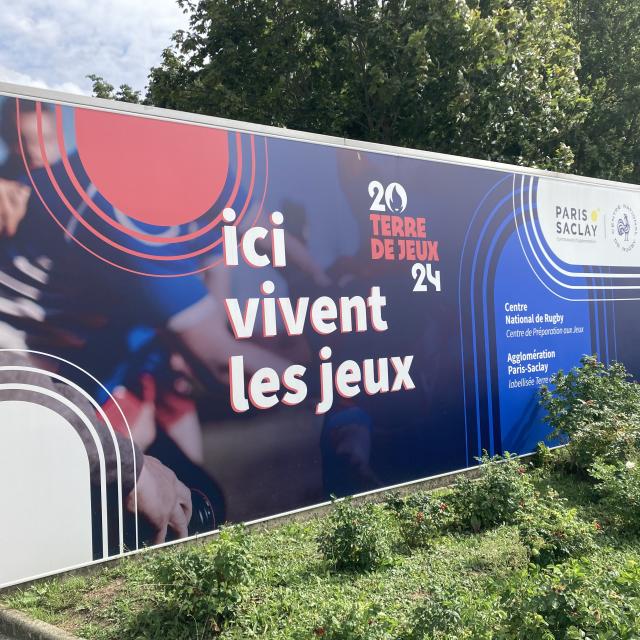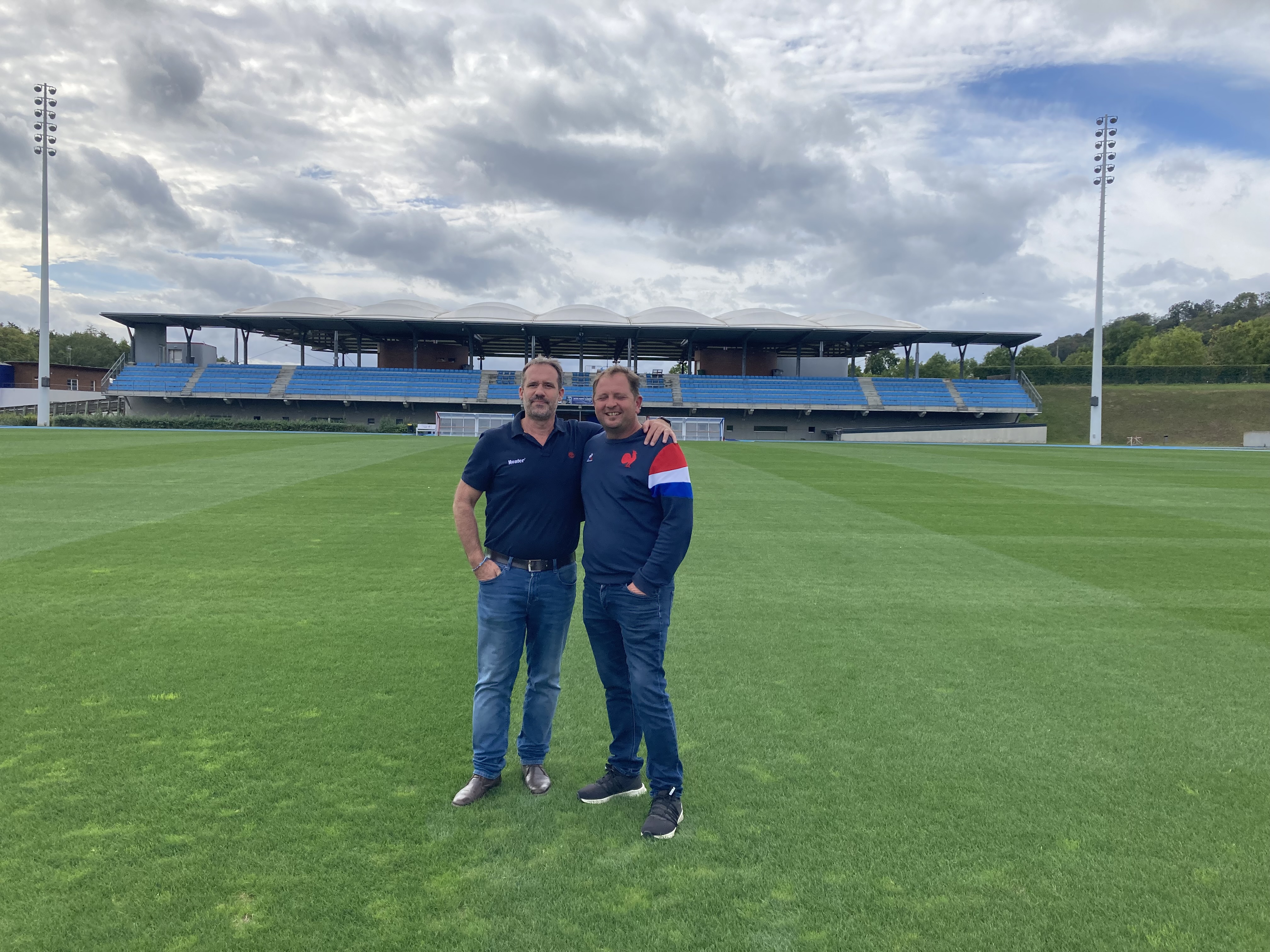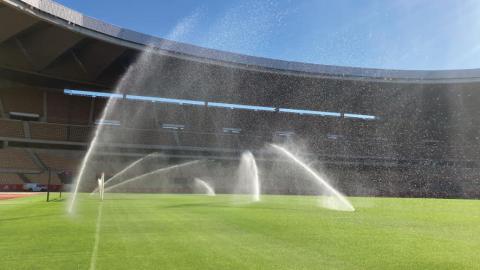I travelled to the French Rugby team’s training centre in Marcoussis (Essonne) on a beautiful afternoon in the month of September. Geoffroy Benoit, head of Hunter’s Northern France sector, met me in a golf buggy and we joined Alexandre Serveau, head of site maintenance, at his offices.

The centre, built in 2002, belongs to the French Rugby Federation and covers 20 hectares. It is the home of the training facilities of the French teams and the headquarters of the French Rugby Federation.
It has 6 rugby pitches, two ponds, several green spaces, the federation’s offices and very luxurious facilities for the players of the French team.
The French team spends twelve weeks per year here for training and preparing for the major international competitions. The players have the use of a VIP lounge, a bar and a restaurant, an indoor swimming pool and a gym, all on a very pleasant site located on the edge of a pond and set in lush greenery.
The hybrid turfs have several benefits
Mr. Serveau was hired by the French Rugby Federation and has passionately managed the site for 14 years. He is responsible for the maintenance of the sports fields and the green spaces on the site.
The site has 6 rugby pitches in total: 2 hybrid pitches, two natural grass pitches (sandy soil) and two synthetic turf pitches, one of which is covered.
“The training sessions of the France XV are conducted on the two hybrid pitches”, explained Mr. Serveau.
The hybrid pitch is the result of a process that combines the benefits of natural grass with the resistance of synthetic turf to create a top-quality playing surface. The AirFibr technology has been chosen for these pitches: this is a system where the natural grass is reinforced with artificial grass fibres. The substrate consists of a mixture of cork, synthetic fibres and sand, and the natural grass is sown on to this substrate.
This technology has several advantages:
• The hybrid pitch is very pliable, which improves the players’ safety and comfort and reduces the risk of injuries.
• The turf cannot be pulled apart and remains green whatever happens.
The hybrid pitches drain well and retain very little water. They can, therefore, be used very frequently.
The only drawback: the hybrid pitches must be renewed every two years.
Having synthetic and hybrid turfs available allows the teams to adapt their week of preparation to the types of pitch on which they are going to play competitively. Furthermore, when there is unfavourable weather in the winter, the players can turn to the covered synthetic pitch.
As far as the natural grass pitches are concerned, they are not required very often and are used by the schools, seminars, the French under-20 team…
A customised irrigation system
We then headed for the pitches, laid out in rows on a sloping site.
Mr. Serveau explained: “each pitch is equipped with a drainage system. Thus, the irrigation water and the rainwater are recovered and channelled into an artificial pond located below the pitches, to be subsequently reintroduced into the system, Water losses are minimal”.

The pond has several sensors installed so that when the water level is low, it is replenished from a nearby borehole. The pumping system was changed this year and a company monitors the water quality in the pond. A filtration system completes the installation.
The controller, which is at the core of the system, has also just been changed: Hunter’s ACC99D controller, which was one of the first generation of decoder controllers, has been replaced with the latest generation ACC2 decoder, connected via a GPRS communication module to the HUNTER “Centralus” web platform, which makes programming easier and ensures better water management. The remote ROAM control and the Smartphone equipped with Centralus can be used to trigger remote watering on all the pitches (Honneur, T2, etc.). Watering is very precise, and the watering lines can be sectorised. This means you can water very targeted areas. Frédérique Paul, a mechanic and fountain technician, frequently takes soundings (using a hand-held probe) to detect areas of the pitch where there is a shortage of water and to react quickly and extremely precisely.
The main pitch is equipped with 41 Hunter I40 and I40 double nozzle sprinklers, which have a very high uniformity coefficient. The sprinklers are all mounted on articulated elbows. The sprinklers are in the ground and the tops of the sprinklers, which are covered with a rubber cover, are at finished ground level and do not risk injuring the players.
The two hybrid pitches and the two natural grass pitches are irrigated, which represents 4 hectares of irrigated grass area.
He added: “The irrigation system for the other two pitches (natural grass, sandy soil) will be renewed this winter. We will be upgrading the installation progressively, with the aim of achieving better water management and greater awareness of the amounts of water applied.”
I then asked Mr. Serveau about the irrigation frequency: “This year, we irrigated in June and July. There was a lot of rain in August so we did not have to irrigate. Currently, we are only irrigating to remove the dew”.
Maintenance of the main pitch
There are two major competitions each year: the Autumn Nations Cup and the 6 Nations Tournament, which take place in October and November respectively, and then from the end of January to March.. The pitch is not used by the French team in December-January so the turf is rested for the winter. We use this period to conduct maintenance and repair operations.
This year is rather special because of the World Cup: the French team is not training at Marcoussis because it has to be treated the same as the other teams, so the main pitch is being rested until February.
They are taking advantage of this long rest period to reseed the turf on the bare areas.
“We have carried out tests on the different grass varieties, which are disease-resistant and efficient in water use”, explained Mr. Serveau.
He added: “During the following two weeks, we make regular 5-minute applications of small amounts of irrigation water so that the grass can root well”.
Cutting the grass is also important at this delicate phase because mowing and rolling allows the turf to become thicker during the growth stage.
The main pitch also has a heating system because, for most of the time, it is reseeded in winter, when the pitch is being rested, and it must not be allowed to freeze.
I asked Mr. Serveau about changes in its water consumption: “I still do not have enough hindsight to enable me to know how much water I will be able to save with this installation. I will be able to give you an answer in one year’s time”.

